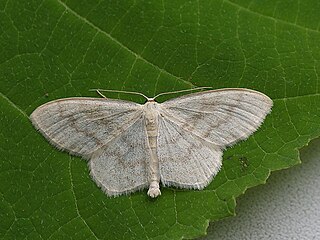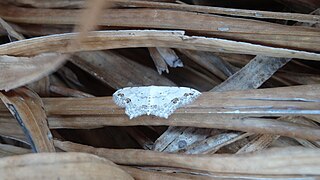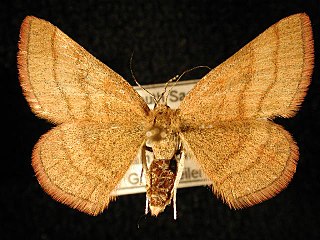
The geometer moths are moths belonging to the family Geometridae of the insect order Lepidoptera, the moths and butterflies. Their scientific name derives from the Ancient Greek geo γεω, and metron μέτρον "measure" in reference to the way their larvae, or inchworms, appear to measure the earth as they move along in a looping fashion. Geometridae is a very large family, containing around 23,000 described species; over 1400 species from six subfamilies are indigenous to North America alone. A well-known member is the peppered moth, Biston betularia, which has been the subject of numerous studies in population genetics. Several other geometer moths are notorious pests.

The cream wave is a moth of the family Geometridae. The species was first described by Adrian Hardy Haworth in 1809. It is found in forest and woodland regions, feeding on grasses and small plants such as dandelion.

Scopula immutata, the lesser cream wave, is a moth of the family Geometridae. It was described by Carl Linnaeus in his 1758 10th edition of Systema Naturae. It is found throughout Europe.

Scopula is a genus of moths in the family Geometridae described by Franz von Paula Schrank in 1802.

Scopula junctaria, the simple wave, is a moth of the family Geometridae. The species was first described by Francis Walker in 1861. It is found in the whole of Canada and the northern United States, south to Maryland, Arizona, and California.
Scopula actuaria is a moth of the family Geometridae. It was described by Francis Walker in 1861. It is found throughout the Oriental tropics of India, Sri Lanka, from Afghanistan and Taiwan to the southern Moluccas and Timor. It is also found on the Chagos Archipelago.

Scopula frigidaria is a moth of the family Geometridae. It was described by Heinrich Benno Möschler in 1869. It is found from Fennoscandia to the Kamchatka Peninsula and in northern North America, where it occurs across the boreal forest region, from Alaska across the Northwest Territories and Nunavut to Newfoundland, and in the mountains south to southern Wisconsin, Alberta and British Columbia.

Scopula lactaria is a moth of the family Geometridae. It was described by Francis Walker in 1861. It is found in Africa south of the Sahara and on some islands of the Indian Ocean. It can be distinguished from Scopula minorata only by genitalia examination.
Scopula addictaria is a moth of the family Geometridae. It was described by Francis Walker in 1861. It is found in Sri Lanka.
Scopula adeptaria is a moth of the family Geometridae. It was described by Francis Walker in 1861. It is found in Sri Lanka, India, Taiwan, Hainan, southern Myanmar, Peninsular Malaysia, Borneo, the Philippines, Sumba and northern Australia.
Scopula apparitaria is a moth of the family Geometridae. It was described by Francis Walker in 1861. It is found in South and Central America, the Greater Antilles and Florida. The type location is Honduras.
Scopula aspilataria is a moth of the family Geometridae. It was described by Francis Walker in 1861. It is found in Sri Lanka.
Scopula cleoraria is a moth of the family Geometridae. It was described by Francis Walker in 1861. It is found in India, Bhutan and Afghanistan.
Scopula compensata, the small frosted wave, is a moth of the family Geometridae. It was described by Francis Walker in 1861. It is found in southeastern North America, including Alabama, Florida, Georgia and South Carolina.
Scopula emissaria is a moth of the family Geometridae. It was described by Francis Walker in 1861. It is found in India, Sri Lanka, Myanmar, Vietnam, China, Korea, Japan, the Philippines, Sumatra, Java, Wallacea and Australia.
Scopula internataria is a moth of the family Geometridae. It was described by Francis Walker in 1861. It is found in Angola, the Comoros, the Democratic Republic of the Congo, Ivory Coast, Kenya, Réunion, Madagascar, Malawi, Mozambique, South Africa, Sudan, Tanzania, Uganda and Zambia.
Scopula nesciaria is a moth of the family Geometridae. It was described by Francis Walker in 1861. It is found in Asia including Sri Lanka, China, the Ryukyu Islands, Taiwan and Indonesia.

Scopula pulchellata is a moth of the family Geometridae. It is found in the Indo-Australian tropics, from India, Sri Lanka to Taiwan and the Solomon Islands, as well as in Africa.

Scopula sentinaria is a moth of the family Geometridae. It is found from Alaska to Labrador, south in the prairies to southern Manitoba, Saskatchewan, Alberta and British Columbia. In the mountains it ranges south to Colorado. The species is also found in northern Russia and the Sayan Mountains. The habitat consists of dry shrubby clearings and edges.
Scopula spoliata is a moth of the family Geometridae. First described by Francis Walker in 1861, it is found in Kenya, Malawi, Somalia, South Africa and Zambia.








